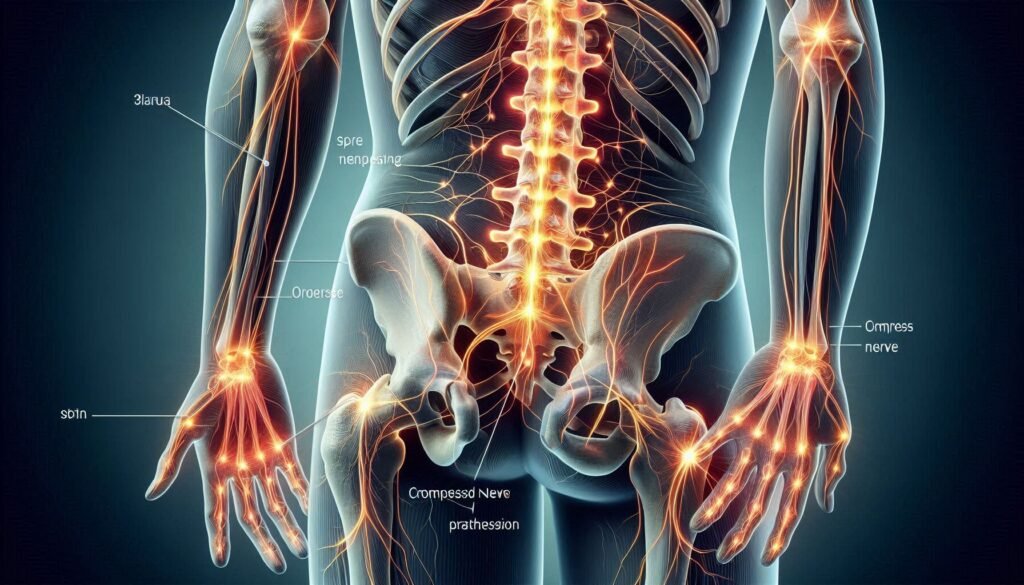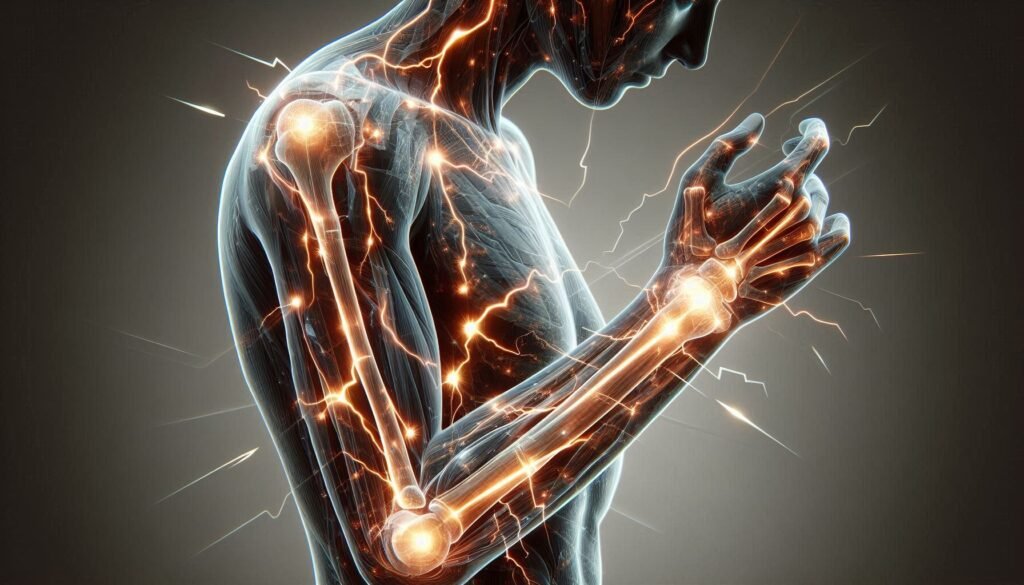Have you ever experienced a tingling sensation in your fingers or toes, only to brush it off as a temporary nuisance? This phenomenon, known as paresthesia, can often be the result of nerve compression. But what exactly does that mean? Understanding how nerve anatomy and function interact with pressure is essential for grasping why certain positions or movements lead to these peculiar sensations.
In this blog post, we’ll delve into the intricate world of nerves—how they work, what causes them to become compressed, and the resulting effects on our bodies. Whether you’re an athlete looking to enhance performance or someone managing chronic discomfort, knowing how nerve compression leads to paresthesia will empower you with valuable insights about your health and well-being. Join us as we unravel this fascinating topic!

Understanding Nerve Anatomy and Function
Nerves are fundamental components of the nervous system, responsible for transmitting signals between the brain and various parts of the body. Comprised of neurons, these specialized cells communicate through electrical impulses. Each nerve consists of bundles of axons, which carry messages to and from muscles, organs, and skin.
The peripheral nervous system (PNS) encompasses all nerves outside the brain and spinal cord. It includes sensory nerves that relay information from external stimuli to the central nervous system (CNS), as well as motor nerves that control muscle movements. This intricate network allows us to react swiftly to our environment.
Nerve function is vital for maintaining balance, coordination, and overall bodily functions. Any disturbance or injury can hinder this communication flow. Understanding how nerves operate helps in recognizing symptoms associated with compression.
When pressure is applied to a nerve—whether through posture or injury—it interrupts its ability to convey signals effectively. This disruption often leads to sensations like tingling or numbness known collectively as paresthesia.
What is Nerve Compression? Causes and Risk Factors
Nerve compression occurs when surrounding tissues exert pressure on a nerve. This can disrupt the nerve’s ability to send signals, leading to various symptoms like tingling or numbness, commonly known as paresthesia. Understanding this condition is crucial for effective diagnosis and treatment.
Several factors contribute to nerve compression. Acute injuries, such as fractures or dislocations, can immediately impact nearby nerves. Chronic conditions like arthritis may lead to swelling that narrows spaces where nerves pass through.
Repetitive movements are another significant cause of nerve compression. Activities that require prolonged awkward positions can exacerbate pressure on nerves over time. Occupations involving repetitive wrist use often see increased cases of carpal tunnel syndrome.
Certain lifestyle choices also elevate risk factors for developing nerve compression issues. Obesity increases body mass and fat deposits around nerves, while diabetes can lead to neuropathy and heightened sensitivity in affected areas. Identifying these causes is essential for prevention and management strategies moving forward.
The Physiology of Nerve Compression: From Pressure to Paresthesia
Nerve compression occurs when excessive pressure is applied to a nerve, disrupting its normal function. This pressure can impede blood flow and oxygen supply, leading to cellular changes within the nerve. As a result, nerve fibers may become inflamed, causing the signals they transmit to become distorted.
Initially, patients might experience tingling sensations or numbness in the affected area. These symptoms arise from altered electrical impulses as the compressed nerve struggles to relay information between the brain and body parts. The sensation of paresthesia—often described as “pins and needles”—is common in these situations.
If left untreated, prolonged compression can lead to demyelination of nerve fibers. Myelin is essential for efficient signal transmission; without it, communication slows down drastically. This disruption results in heightened sensitivity or even pain along with persistent numbness.
Understanding this physiological process highlights why prompt intervention is crucial for anyone experiencing symptoms of nerve compression before more severe damage occurs.
Common Sites of Nerve Compression in the Body
Nerve compression can occur in various areas of the body, leading to uncomfortable sensations and impaired function. One common site is the wrist, particularly with conditions like carpal tunnel syndrome. Here, the median nerve gets pinched as it travels through a narrow passage.
Another frequent location is around the elbow. The ulnar nerve may become compressed in what’s known as cubital tunnel syndrome. This often results in tingling or numbness along the little finger and half of the ring finger.
The neck also serves as a critical area for potential nerve compression. Cervical radiculopathy occurs when spinal nerves are irritated or pinched due to herniated discs or bone spurs, causing symptoms that radiate down into an arm.
Pressure on nerves can happen at the hip during prolonged sitting or crossing legs. Conditions like meralgia paresthetica result from compression of the lateral femoral cutaneous nerve, leading to sensations of burning or tingling on your thigh.
Carpal Tunnel Syndrome: A Classic Example of Compression-Induced Paresthesia
Carpal Tunnel Syndrome (CTS) is one of the most common examples of nerve compression leading to paresthesia. This condition occurs when the median nerve, which runs through the wrist’s carpal tunnel, becomes compressed. The result is tingling, numbness, or a burning sensation in the hand and fingers.
Several factors can contribute to this compression. Repetitive hand movements, such as typing or using tools, are significant culprits. Additionally, conditions like diabetes and rheumatoid arthritis can make individuals more susceptible to developing CTS.
Symptoms often start gradually and may worsen over time. Individuals might feel discomfort while holding objects or experience pain that disrupts sleep. Ignoring these signs can lead to chronic problems if not addressed promptly.
Diagnosis typically involves physical exams and tests like electromyography (EMG). Treatment options range from lifestyle changes and splinting to corticosteroid injections or even surgery in severe cases aimed at relieving pressure on the affected nerve.
Cervical Radiculopathy: When Spinal Nerves Are Compressed
Cervical radiculopathy occurs when spinal nerves in the neck become compressed or irritated. This condition often arises from herniated discs, bone spurs, or degenerative disc disease. The resulting pressure disrupts normal nerve function, leading to various symptoms.
Individuals with cervical radiculopathy may experience pain that radiates down the arm and into the hand. Alongside pain, weakness and numbness can affect grip strength and overall dexterity. These sensations are due to disrupted signals traveling through affected nerves.
The location of discomfort typically corresponds to which nerve root is impacted. For instance, compression at a specific level might cause issues primarily in the shoulder or forearm area. Understanding these patterns helps healthcare providers diagnose and treat effectively.
Diagnosis often involves imaging tests like MRIs or CT scans to visualize nerve compression sources clearly. Treatment options range from physical therapy to surgical intervention in severe cases, aiming to alleviate pressure on compromised nerves for better quality of life.
Cubital Tunnel Syndrome: Ulnar Nerve Compression at the Elbow
Cubital Tunnel Syndrome occurs when the ulnar nerve, one of the main nerves in the arm, becomes compressed at the elbow. This compression can lead to pain, tingling, and numbness especially on the outer side of your hand and ring fingers. It’s often described as a sensation that feels like hitting your “funny bone.”
Several factors contribute to this condition. Prolonged bending of the elbow can increase pressure on the ulnar nerve. Repetitive activities such as typing or throwing can also exacerbate symptoms over time. Individuals who frequently rest their elbows on hard surfaces are particularly at risk.
Symptoms may worsen during sleep when bending is more likely to occur unintentionally. Many people find relief by changing positions or shaking out their arms but might experience persistent discomfort.
Diagnosis usually involves physical examinations and diagnostic tests like electromyography (EMG) or nerve conduction studies to confirm ulnar nerve involvement. Early detection is key for effective management and treatment options.
Diagnosing Nerve Compression: Medical Tests and Procedures
Diagnosing nerve compression typically begins with a thorough medical history and physical examination. Physicians often assess symptoms, like tingling or numbness, to pinpoint the affected area. This initial evaluation helps determine whether further testing is needed.
Electromyography (EMG) and nerve conduction studies are common diagnostic tools. EMG measures electrical activity in muscles, while nerve conduction studies evaluate how well signals travel along nerves. Together, they can reveal issues related to nerve function and identify specific areas of compression.
Imaging tests may also play a critical role in diagnosis. Magnetic resonance imaging (MRI) provides detailed images of soft tissues, helping doctors visualize any structural abnormalities that may be compressing nerves. X-rays can reveal bone spurs or other skeletal issues contributing to pressure on nerves.
Advanced techniques like ultrasound may be utilized as well for real-time visualization of nerve structures. These tests enable healthcare providers to develop effective treatment plans tailored to each patient’s unique situation.
Treatment Options for Compression-Induced Paresthesia
Treatment for compression-induced paresthesia often begins with conservative methods. Resting the affected area can alleviate pressure on the nerve, allowing it to heal naturally. Applying ice or heat may also provide relief from discomfort and swelling.
Physical therapy is another effective approach. A trained therapist can guide patients through exercises designed to strengthen surrounding muscles and improve flexibility. This helps reduce future instances of nerve compression.
In some cases, medications may be prescribed to manage pain and inflammation. Non-steroidal anti-inflammatory drugs (NSAIDs) are commonly recommended for this purpose. Corticosteroid injections might also be considered if symptoms persist.
If conservative treatments fail, surgical intervention might be necessary. Procedures vary based on the location of nerve compression but typically aim to relieve pressure by removing tissue or repairing anatomical structures associated with the compressed nerve.
Prevention Strategies: Protecting Your Nerves from Compression
Preventing nerve compression is crucial for maintaining optimal nerve function and avoiding the discomfort of paresthesia. Simple lifestyle modifications can go a long way in protecting your nerves.
First, be mindful of your posture. Whether sitting at a desk or lifting objects, maintaining good alignment helps reduce undue pressure on nerves. Ergonomic furniture can support this effort.
Regular breaks during repetitive tasks are essential as well. If you work at a computer or perform similar motions, take short breaks to stretch and change positions. This practice reduces strain on specific areas where nerves might become compressed.
Incorporating flexibility and strength training exercises into your routine also aids prevention. Strong muscles provide better support for joints and reduce the risk of injury that could lead to compression issues.
Stay aware of any symptoms like tingling or numbness early on so you can address them promptly with medical help if needed. By taking these proactive steps, you empower yourself to keep your nerves healthy and functional while minimizing the chances of experiencing paresthesia due to nerve compression.


